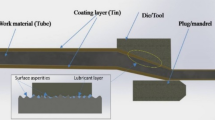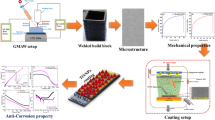Abstract
In this paper, the tin coating layer is utilized as a solid lubricant for the cold steel tube drawing process. The effect of different thicknesses of tin coatings as a tribo-layer has been investigated. The electroplating process has been used for depositing a tin coating layer by deploying an environmentally benign citric acid–based electrolyte bath and the layer thickness is controlled by varying the time of the electroplating process. Characterization of the coating layer is carried out using SEM, EDS, and 3D digital microscopy techniques. Experimental trials of the tube drawing process have been conducted for tin-coated tubes and the effects on drawing force and surface roughness have been analyzed. The draw force gradually decreases and reaches a minimum value as the tin layer thickness increases from 4.5 to 16.5 μm, while for further increase in layer thickness, the draw force increases again, yielding an optimal tin layer thickness of around 16.5 μm. The drawn tube samples are found to have a superior surface finish with roughness (Ra) as low as 0.165 μm even for the smallest tin coating thickness of around 5 μm while it improves marginally up to 0.134 μm when the tin layer thickness is increased gradually to around 25.7 μm. A sizeable thickness of tin coating is retained on the drawn tube, which enhances the surface appearance as well as corrosion resistance. The tape adhesion test was carried out as per the ASTM D3359 standard and it confirmed the adequacy of adhesion of the coating on the drawn tubes. Also, comparison of draw force variation with the well-known Stribeck curve and the insights into the working mechanism of soft metal as a lubricant are presented.
Graphical abstract















Similar content being viewed by others
Availability of data and material
The author can provide the data used in this study upon request.
Code availability
Not applicable.
References
Swiatkowski K, Hatalkar R (2004) Study of the new floating-plug drawing process of thin walled tubes. J Mater Process Technol 151:105–114. https://doi.org/10.1016/j.jmatprotec.2004.04.024
Gattmah J, Ozturk F, Orhan S (2017) Experimental and finite element analysis of residual stresses in cold tube drawing process with a fixed mandrel for AISI 1010 steel tube. Int J Adv Manuf Technol 93:1229–1241. https://doi.org/10.1007/s00170-017-0583-8
USITC (2018) Cold-drawn mechanical tubing from China and India, Publication 4755, United States International Trade Commission (USITC), Investigation Nos. 701-TA-576–577, Washington DC
Naves FO, Buton ST, Caminaga C, Gentile FC (2005) Numerical and experimental analysis of tube drawing with fixed plug. J Braz Soc Mech Sci Eng 27:426–431
Bay N, Azushima A et al (2010) Environmentally benign tribo-systems for metal forming. Ann CIRP-Manuf Technol 59:760–780. https://doi.org/10.1016/j.cirp.2010.05.007
Groche P, Zang S, Müller C, Bodenmüller D (2015) A study on the performance of environmentally benign lubricants at elevated temperatures in bulk metal forming. J Manuf Process 20:425–430. https://doi.org/10.1016/j.jmapro.2014.06.004
Herrmann C, Cerdas C, Abraham T, Büth L, Mennenga M (2020) Biological transformation of manufacturing as a pathway towards environmental sustainability: Calling for systemic thinking. CIRP J Manuf Sci Technol. https://doi.org/10.1016/j.cirpj.2020.10.008
Barnett K (2003) Development of replacements for phoscoating used in forging, extrusion and metal forming processes. National Center for Manufacturing Sciences. Ann Arbor, Michigan, USA. https://doi.org/10.2172/809127
Bihamta R, Bui QH et al (2012) Application of a new procedure for the optimization of variable thickness drawing of aluminium tubes. CIRP J Manuf Sci Technol 5:142–150. https://doi.org/10.1016/j.cirpj.2012.03.006
Joun MS, Moon HG et al (2009) Effects of friction laws on metal forming processes. Tribol Int 42:311–319. https://doi.org/10.1016/j.triboint.2008.06.012
Wang N, Rui M, Juan Z, Zhao J (2013) Calculation method and experimental study of coulomb friction coefficient in sheet metal forming. J Manuf Process 7:126–137. https://doi.org/10.1016/j.jmapro.2017.02.016
Sagisakaa Y, Tamotsu N, KunioH II (2013) Evaluation of environmentally friendly lubricant for aluminum cold forging using friction test based on spline extrusion. J Manuf Process 15:96–101. https://doi.org/10.1016/j.jmapro.2012.09.006
Nowak P, Karolina K, Marian K (2019) Ecological and health effects of lubricant oilsemitted into the environment. Int J Environ Res Public Health 16:3002. https://doi.org/10.3390/ijerph16163002
Boris Z, Bogdan P (2013) Nanomaterials in lubricants: an industrial perspective on current research. Lubricants 1:95–101. https://doi.org/10.3390/lubricants1040095
Bart JCJ, Emanuele G, Stefano C (2013) Bio-lubricants, bio-lubricants science and technology, Woodhead Publishing Series in Energy
Rodriguez MR, Tomal AM, Totolin V, Remskar M (2019) Performance of nano-lubricants containing MoS2 nanotubes during form tapping of zinc-coated automotive components. J Manuf Process 39:167–180. https://doi.org/10.1016/j.jmapro.2019.02.012
He J, Sun J, Meng Y, Pei Y (2020) Superior lubrication performance of MoS2-Al2O3 composite nanofluid in strips hot rolling. J Manuf Process 57:312–323. https://doi.org/10.1016/j.jmapro.2020.06.037
Shankara A, Menezes PL, Simha K, Kailas SV (2008) Study of solid lubrication with MoS2 coating in the presence of additives using reciprocating ball-on-flat scratch tester. Sadhana 33:207–220. https://doi.org/10.1007/s12046-008-0014-5
Tamotsu N, Shigekazu T, Kunio H, Yoshiaki F (2000) A study of the lubrication behavior of solid lubricants in the upsetting process. J Tribol 122:803–808. https://doi.org/10.1115/1.1310159
Patil M, Singh V, Bade S, Krishna S (2020) Effect of lubrication technique in tube drawing. Materials Today: Proceedings 28(1):426–431. https://doi.org/10.1016/j.matpr.2019.10.027
Loffler M, Engel U, Willner K, Beyer F, Merklein M (2018) Investigation of the tribolgocal behaviour of microstructures for controlling the material flow in sheet-bulk metal forming. CIRP J Manuf Sci Technol 22:66–75. https://doi.org/10.1016/j.cirpj.2018.05.002
Wu Z, Bao H, Xing Y et al (2021) Tribological characteristics and advanced processing methods of textured surfaces: a review. Int J Adv Manuf Technol 114:1241–1277. https://doi.org/10.1007/s00170-021-06954-2
Regalla SP, Anirudh KV, Narela S (2018) Tribological performance of zinc soft metal coatings in solid lubrication. IOP Conf Ser Mater Sci Engg 346:012–022. https://doi.org/10.1088/1757-899X/346/1/012022
Miyoshi K (2007) Solid lubricants and coatings for extreme environments: state-of-the-art survey. NASA/TM-2007–214668, Glenn Research Center, Cleveland, Ohio
Zhang ZJ, Simionesie D, Schaschke C (2014) Graphite and hybrid nano materials as lubricant additives. Lubricants 2:44–65. https://doi.org/10.3390/lubricants2020044
Wisander DW (1971) Lead, indium and tin as potential lubricants in liquid hydrogen. NASA/ TN D-6455, Lewis Research Center, Cleveland, Ohio
Sherbiney MA, Halling J (1977) Friction and wear of ion-plated soft metallic film. Wear 45:211–220. https://doi.org/10.1016/0043-1648(77)90075-8
Patil M, Singh V et al (2021) Tin layer as a solid lubricant for cold tube drawing processes. Int J Precis Eng Manuf Green Tech. https://doi.org/10.1007/s40684-020-00301-8
Okamoto N, Wang F, Watanabe T (2004) Adhesion of electrodeposited copper, nickel and silver films on copper, nickel and silver substrates. Mater Trans 45:3330–3333. https://doi.org/10.2320/matertrans.45.3330
David GD (2018) Surface treatments of selected materials. In Da-Silva LDM, Ochsner A., Adams A.D. (Eds), Handbook of Adhesion Technology, Springer, Charm
Walsh FC, Low CTJ (2016) A review of developments in the electrodeposition of tin. Surf Coat Technol 288:79–94. https://doi.org/10.1016/j.surfcoat.2015.12.081
ASTM D3359 (2014) Standard test methods for measuring adhesion by tape test. Copyright by ASTM International, West Conshohocken, United States
Dieter GE, Howard AK, Lee S (2003) Handbook of workability and process design. ASM International, United States of America. https://doi.org/10.1361/hwpd2003p278
Blazynski TZ (1976) Wire, rod and tube drawing. In: Metal forming. Palgrave, ASME international, London. https://doi.org/10.1007/978-1-349-02861-0_6
Jacobson BO (2003) The Stribeck memorial lecture. Tribol Int 36:781–789. https://doi.org/10.1016/S0301-679X(03)00094-X
Marcia MM, Deniol KT (2007) Consideration of Stribeck diagram parameters in the investigation on wear and friction behavior in lubricated sliding. Braz Soc Mech Sci Eng 29:55–61. https://doi.org/10.1590/S1678-58782007000100009
Bayer RG (1994) Mechanical wear prediction and prevention. Wiley Online Library 31:115–121. https://doi.org/10.1111/j.1475-1305.1995.tb00971.x
Hutchings I, Gee M, Santner E (2006) Friction and wear, In: Czichos H, Saito T, Smith L(eds). Springer Handbook of Materials Measurement Methods, Springer, Berlin, Heidelberg 685–709
Hirai T, Ishise T (1986) Plastic metal flow under frictional boundary in forward extrusion die and stress distribution of the die. Int Jr Mach Tool Des Res 26:17–29. https://doi.org/10.1016/0020-7357(86)90001-6
Joun MS (1999) Iterative and non-iterative schemes for coulomb frictional law in metal forming simulation and their numerical characteristics. Commun Numer Methods Eng 15:515–525. https://doi.org/10.1002/(SICI)1099-0887(199907)15:7%3c515:AID-CNM266%3e3.0.CO;2-A
Ramezani M, Ripin ZM (2010) A friction model for dry contacts during metal-forming processes. Int J Adv Manuf Technol 51:93–102. https://doi.org/10.1007/s00170-010-2608-4
Bowden FP, Tabor D (1951) The friction and lubrication of solids. Am J Phys 19:428–430. https://doi.org/10.1119/1.1933017
Lee CH, Kobayashi S (1973) New solutions to rigid-plastic deformation problems using a matrix method. ASME Trans J Manuf Sci Eng 95:865–873. https://doi.org/10.1115/1.3438238
Sivaprasad PV, Davies CHJ (2005) An assessment of the interface friction factor using the geometry of upset specimens. Model Simul Mater Sci Eng 13:355–600. https://doi.org/10.1088/0965-0393/13/3/005
Acknowledgements
The authors express sincere thanks for the financial support from Tube Investments of India Ltd., Chennai, India, for this research work. In addition to financial support, extensive support was provided for carrying out experimental investigations at the research and development facilities at the company premises. We thoroughly acknowledge all the support received.
Funding
This work has been funded by Tube Investments of India Ltd., Chennai, India, with a research grant worth INR 2.745 million.
Author information
Authors and Affiliations
Contributions
The corresponding author, MP, has been responsible for conducting the experiments, data collection and analysis, and original draft preparation. VS is responsible for the conceptualization, data analysis, result interpretation, writing and reviewing this paper. SPR, AKG, and TCB have been responsible for the conceptualization, structuring, and revising of this paper. SB and KS are responsible for the experimental setup development, planning, and coordinating the research activities for this work.
Corresponding author
Ethics declarations
Ethics approval
Not applicable.
Consent to participate
Not applicable.
Consent for publication
The authors consent to publish this article.
Conflict of interest
The authors declare no competing interests.
Additional information
Publisher's note
Springer Nature remains neutral with regard to jurisdictional claims in published maps and institutional affiliations.
Rights and permissions
About this article
Cite this article
Patil, M., Singh, V., Regalla, S.P. et al. Producing high quality cold-drawn steel tubes using an optimal thickness of tin as a tribo-layer. Int J Adv Manuf Technol 121, 4663–4675 (2022). https://doi.org/10.1007/s00170-022-09537-x
Received:
Accepted:
Published:
Issue Date:
DOI: https://doi.org/10.1007/s00170-022-09537-x




